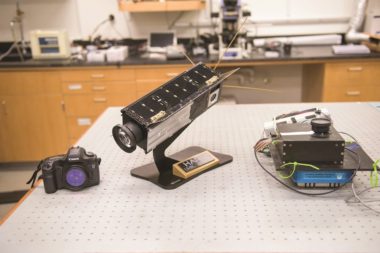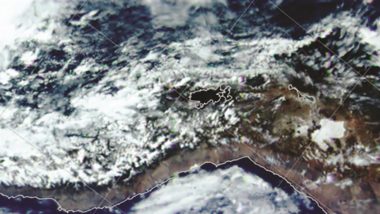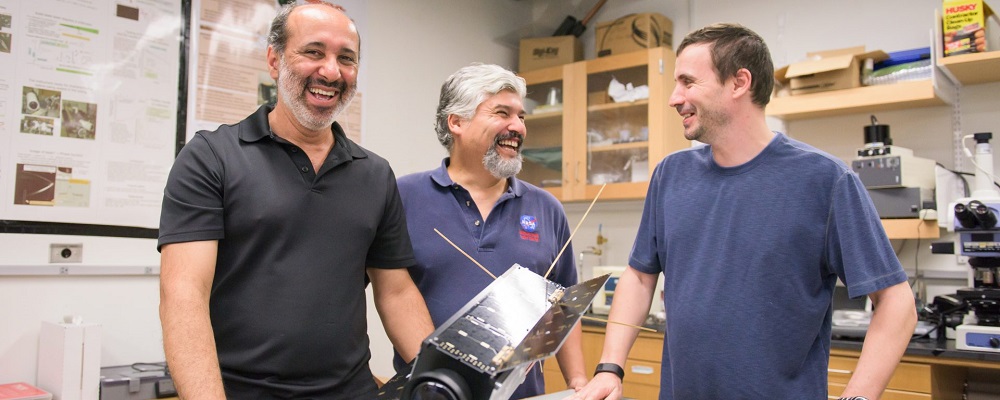How NASA’s InVEST program is yielding big dividends for future Earth-observing missions
For the last several years at the Small Satellite Conference, the American Institute of Aeronautics and Astronautics (AIAA) has held a “Small Satellite Mission of the Year” competition. An AIAA committee gathers nominations for smallsats that have launched in the last year and selects a group of finalists announced as the conference gets underway, allowing conference attendees and others to vote for their favorite. At the end of the conference, the AIAA committee announces the winner.
That tradition continued this year even as the conference moved from the Utah State University campus to the internet. This year, the winner was Hyper-Angular Rainbow Polarimeter (HARP), an Earth science cubesat deployed from the International Space Station in February, three months after its launch to the station on a Northrop Grumman Cygnus cargo spacecraft.
HARP, operated by the Space Dynamics Lab (SDL) at Utah State, carries an instrument developed at the University of Maryland, Baltimore County to study cloud and aerosol particles in the atmosphere. Just as the conference started, the mission released the first data from HARP, confirming the instrument was working as expected and, perhaps, boosting its chances in the competition.
The primary purpose of HARP is to test the instrument’s technology as the team that developed it works on a more advanced version, called HARP2, that will fly on NASA’s Plankton, Aerosol, Cloud, ocean Ecosystems (PACE) mission, a much larger spacecraft launching in 2023. The mission, though, also intends to show off what a spacecraft as small as HARP — a three-unit cubesat weighing six kilograms — can do in terms of science.
“The application of space-based Earth observation technology has historically been the domain of large satellites,” said Tim Neilsen, program manager for HARP at SDL. “HARP helps to confirm that miniaturized sensors on small satellites can provide a high degree of fidelity at a fraction of the cost and time it takes to build larger satellites.”
InVESTing in Earth science smallsat technologies
NASA funded development of HARP through an effort called In-space Validation of Earth Science Technologies, or InVEST. The program, part of the agency’s Earth Science Technology Office that also supports instrument and subsystem technology development, funds cubesat-class missions to flight-qualify Earth science instruments and related systems.

InVEST holds an open call for missions every few years, with the next scheduled for later this year, said Sachidananda Babu, InVEST program manager, in an interview. Those solicitations are kept as broad as possible to encourage a wide range of concepts, letting the peer review process determine which is best.
InVEST claims a success rate of nearly 90% for its missions to date, which Babu credits to close working relationships with the principal investigators (PIs) of the selected proposals. “We constantly interact with the PIs, and if the PI has a problem, I take it on myself to go look for a solution,” he said. His office also works with others at NASA involved with small satellites, sharing information on smallsat components and suppliers.
That success can take time, though. HARP was the last of the four missions selected in the first InVEST round in 2012 to launch. The other three missions, cubesats to test radiometers and GPS radio occultation technologies, launched in 2016 and 2017. HARP, Babu said, suffered technical problems that caused it to be manifested seven times before it finally launched last year. “It can be a long process.”
Despite delays for some missions, InVEST has excelled in developing advanced instruments small enough to fit into a cubesat. An example Babu cited is an instrument known as a spectral irradiance monitor, used to measure energy from the sun that is a key factor in climate models. A version of such an instrument, developed for a six-unit cubesat called CSIM, was one-tenth the mass of a similar instrument flown on the SORCE spacecraft launched in 2003, but with much higher quality data.
The current focus of InVEST is on four missions selected in 2017, with names often as creative as their technologies. The Signals of Opportunity: P-band Investigation, or SNoOPI, will measure signals scattered off the Earth’s surface from communications satellites broadcasting at P-band, or UHF, frequencies, such as the U.S. Navy’s Mobile User Objective System satellites. Those signals can probe as deep as a meter into the surface, allowing measurements of subsurface moisture at the level of plant roots.
Another is the Nanosat Atmospheric Chemistry Hyperspectral Observation System, or NACHOS. It will demonstrate a high-resolution hyperspectral sensor intended to identify fossil fuel emissions in the atmosphere as well as gases from volcanoes.
It’s not just instruments being demonstrated on InVEST missions. Both NACHOS and another InVEST cubesat in development, the Hyperspectral Thermal Imager, will also test the use of onboard processing to reduce the amount of data they have to return to Earth.
That’s critical, Babu said, for hyperspectral sensors that generate huge volumes of data. “You can’t download everything that you look at,” he said. “Even if data download is not a problem at this point, it is going to be in the next 5 or 10 years. No matter how many ground stations you build, you cannot accommodate everything.”
He added he’s encountered problems getting scientists to accept that they won’t get all the raw data their sensors collect. “Every time I talk to a scientist, they tell me they want to see everything,” he said, fearing they will miss the proverbial needle in the haystack. “It is always a struggle.”
Smallsat roles and challenges
The InVEST cubesats are primarily intended for technology demonstration to support future missions, as HARP is doing for the instrument that will later fly in the PACE mission. However, these missions can also carry out science, working in conjunction with, or sometimes in place of, larger operational missions.
“Many times big missions may have gaps in data,” Babu said. “Big missions cannot be everywhere all the time.” One example was when Hurricane Dorian moved up the East Coast last year. NASA’s Global Precipitation Measurement spacecraft was not able to observe it one day. Instead, an InVEST cubesat, TEMPEST-D, flew over the hurricane and collected data in its place.
“Cubesats can be gapfillers to big missions,” he said. “They may not become the primary mission, but they can be gapfillers.”
One of the major selling points for smallsats has been the ability to affordably fly constellations of dozens or even hundreds of such spacecraft, providing global coverage with frequent revisits not possible with larger spacecraft. It’s the approach companies like Planet and Spire have followed with their commercial constellations for Earth imagery and weather data.

At an Aug. 19 SmallSat Alliance webinar meeting, Karen St. Germain, who took over as director of NASA’s Earth science division in June, endorsed the concept of a “hybrid space architecture” that makes greater use of smallsats in conjunction with traditional larger satellites. “Many observations we can make with smaller constellations,” she said. “We can be more agile. We can infuse technology more often.”
However, she stressed the challenges NASA faced with using smallsats for Earth science missions. One key issue is the quality of the data. “Every pixel value counts,” she said. “It’s a very precise and accurate measurement because, in many cases, we’re looking for small changes.”
That’s accomplished for larger spacecraft with rigorous calibration efforts. “If we talk about a fleet of a dozen smaller payloads flying on smaller spacecraft, the challenge we have is that those historical techniques don’t scale particularly well,” she said. The problem is compounded by the approach of frequently launching new smallsats with updated technologies, which then need to be calibrated to ensure consistency with data from older missions. “It requires some really careful attention.”
Another issue is working with the broader smallsat industry. “This community doesn’t necessarily go to the forums that we have historically relied on to interface with industry,” St. Germain told the smallsat industry group. Since many smaller missions are competed, there’s a need to help scientists make connections with companies that can offer spacecraft or components for their proposed missions.
Many InVEST missions use cubesat buses or other components provided by companies. Babu said they’ve frequently run into problems with components like memory cards, radios and batteries, and companies are often reticent to share technical details about them, saying they are proprietary.
St. Germain said there will continue to be a role for large Earth science missions, which have the size, power and other capabilities needed to achieve the agency’s science goals. But hybrid architectures that make more use of smallsats open new capabilities. “We can look at the trade space between spatial resolution and temporal resolution,” she said. “It allows us to tailor the architecture solution to the question we’re asking.”
A smallsat mission that helps enable such a hybrid architecture might well be a front-runner for a future Small Satellite Mission of the Year award.
This article originally appeared in the Sept. 14, 2020 issue of SpaceNews magazine.
